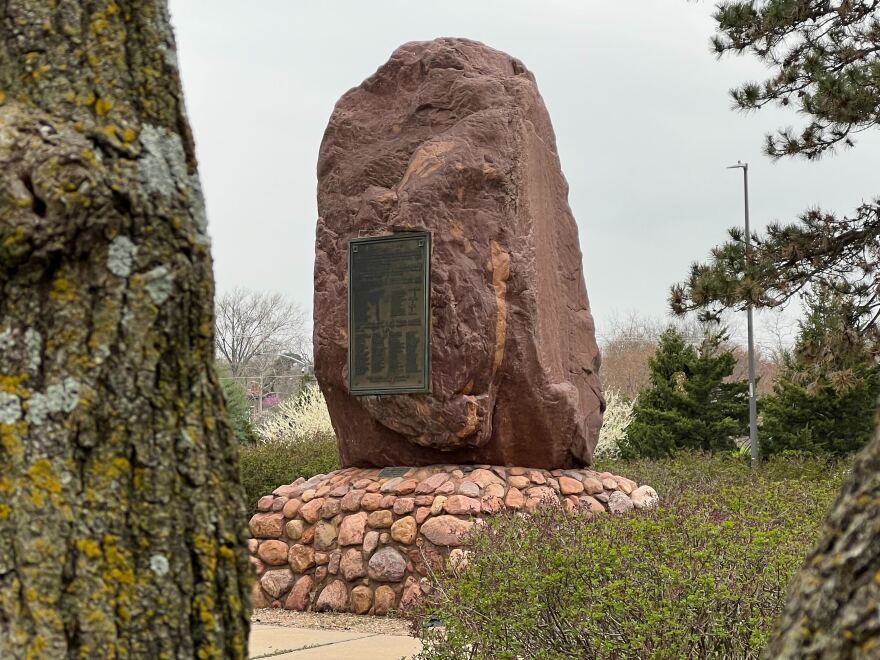LAWRENCE – A massive sacred rock is leaving downtown Lawrence Wednesday on a trip to its new home at the site of the Kaw Nation’s last village in Kansas near Council Grove.
This summer marks 150 years since the federal government forced the tribe’s last residents in Kansas from the state, sending them on a two-week journey to Indian Territory in what is now Oklahoma.
The ceremony marked the return of a 28-ton red quartzite boulder to the Kaw people. Descendants of white settlers took the boulder nearly a century ago, placed it in Lawrence and turned it into a monument to the city’s founders.
“White settlers that came into this area were leaving their homelands to escape oppression and suppression — and coming here for freedom,” Kaw Nation Vice Chairman Jim Pepper Henry said after a ceremony in Lawrence on Tuesday. “But we were truly free people and we had our freedom taken away.”

The boulder had stood east of Topeka, at the confluence of the Kansas River and Shunganunga Creek. Called Iⁿ'zhúje'waxóbe in the Kaw language, it was a gathering place where the Kaw prayed to God, Pepper Henry said.
Many of Lawrence’s early settlers were abolitionists seeking to end slavery or came from parts of Europe where their families had faced oppression. But their beliefs about freedom did not extend to the Kaw and other Native Americans who had lived in the area for centuries.
Kansas is named after the Kaw, also known as the Kanza. In the early 1800s, the tribe controlled nearly half of what is now Kansas, before being forced from the state.
Lawrence Mayor Lisa Larsen read aloud an apology from the city and Douglas County.
“The citizens of Lawrence defaced Iⁿ'zhúje'waxóbe,” the resolution reads, referring to the plaque honoring city founders that until recently sat on the boulder’s surface.
“The city and the county further express deep regret,” the resolution reads, “for the history of violence, the maltreatment, the neglect and the pernicious policies of the United States government and other units of government.”
The Kaw Nation will move the rock to Allegawaho Memorial Heritage Park near Council Grove. The tribe has owned this portion of its final reservation in Kansas since 2002.
Kaw Chairwoman Kim Jenkins said the first time she visited the site for a powwow, the experience moved her.

“Every time I’ve come to Kansas,” she said. “It just feels settling … I’m home.”
The Kaw Nation has about 3,900 members. It is headquartered in Kaw City, Oklahoma.
Kansas Gov. Laura Kelly, a Democrat, said the rock was taken “before Kansans understood and valued tribal peoples.”
“Today we realize the significance of this rock to the Kansas Nation and the need for restoration and healing,” she said.
Kelly said she recently granted return of sacred burial places to the Kaw and Shawnee Nations, including a half-acre site in Shawnee. She also said this year’s budget allows in-state university tuition for people who don’t currently live in Kansas but who are members of tribes with historic ties to it.
However, the Kaw would like to see full scholarships for its members, Pepper Henry said, because the tribe has “prepaid exponentially for this education with our sacrifices and our blood.”
“The sale of our Kaw lands funded the endowments and operating support of Kansas State University and other institutions of higher learning,” he said. “At the same time, our children were taken from our families and sent to government supported parochial boarding schools — not to become doctors and lawyers, but to be molded into servants and laborers.”
In the 1700s, the Kaw numbered more than 10,000 people. Europeans brought disease, violence and relocation that devastated the tribe. By 1900, only about 200 Kaw remained.
Brittany Dias, a Kaw Nation member, drove from Tulsa with her two children to attend the ceremony. Ultimately, she looks forward to seeing the rock in place at Allegawaho.
“It’ll be healing and medicine,” she said. “For us, it’s just going to be something that’s right.”
“I feel super lucky to be here right now,” her 11-year-old daughter, Aria Eckstein, said.

“It’s been a long time coming,” said Jaelin Kent, great-great-granddaughter of the 19th century Kaw leader, Chief Allegawaho. “I’m glad it’s finally happening.”
Pepper Henry applauded Lawrence city officials for backing their words with action. He contrasted this with universities that have recently begun issuing public acknowledgments that they occupy land formerly home to Native American tribes.
“People think it absolves them of this greater responsibility with regard to reconciliation,” he said. “They’re hollow words.”
He appreciates that Lawrence city officials apologized, were “brutally honest about what happened,” and backed those words with action to return the sacred rock.
Celia Llopis-Jepsen is the environment reporter for the Kansas News Service. You can follow her on Twitter @celia_LJ or email her at celia (at) kcur (dot) org.
The Kansas News Service is a collaboration of KCUR, Kansas Public Radio, KMUW and High Plains Public Radio focused on health, the social determinants of health and their connection to public policy.
Kansas News Service stories and photos may be republished by news media at no cost with proper attribution and a link to ksnewsservice.org.





